Colourful skittles are the ones among those delicious candies kids enjoy during Halloween and even throughout the year.
If you are left with too many skittles in your home after your Halloween party, do not put them into trash.
Instead save them because today I am here to tell you an awesome science activity using your child’s favourite candy, skittles.
Are you excited to learn what such amazing experiment that teaches science concepts is!? Then, continue reading…
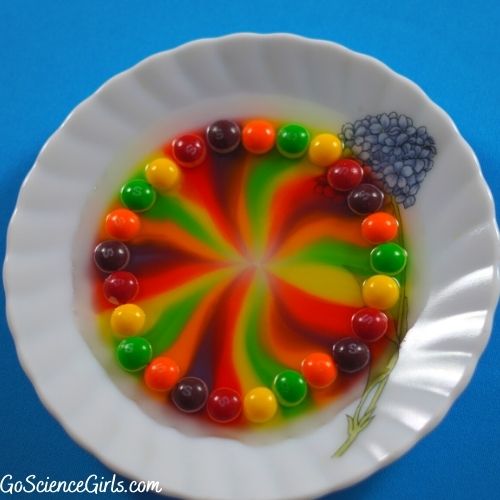
Skittles Rainbow Science Experiment
This science activity is so simple to do and offers a ton of fun and education.
Objective: To create a beautiful Rainbow using skittles and learn the simple science concepts like absorption, color mixing and dissolving
Safety Measures: As we are using all non-toxic ingredients, it is completely safe to investigate this activity.
Age Group: Kids of 3-8 years old are perfect for this activity. Kindergarten and toddlers can receive this activity as a sensory play and learns mixing colors. While the elementary children enjoys the fun and learns the simple science involved in the activity.
Materials Required
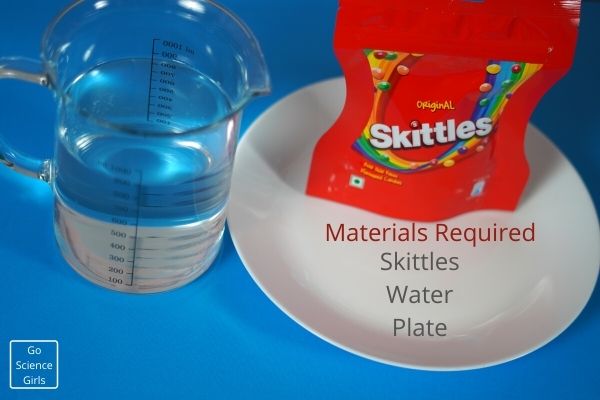
- Bright and different colored skittles (You can collect as many different colors as you want)
- White ceramic or plastic plate or bowl
- Warm water in a jar
Instructions to do Simple Skittles Rainbow Experiment
The instructions to skittles rainbow activity are as simple as putting a skittle in your mouth.
Step-1: Clean the Ceramic Plate
Make sure you are using clean and fresh ceramic plate to avoid untimely other reactions due to the remnants that are stuck to the plate. Also use fresh and clean water to get perfect results.
Step-2: Arrange the Skittles on Plate
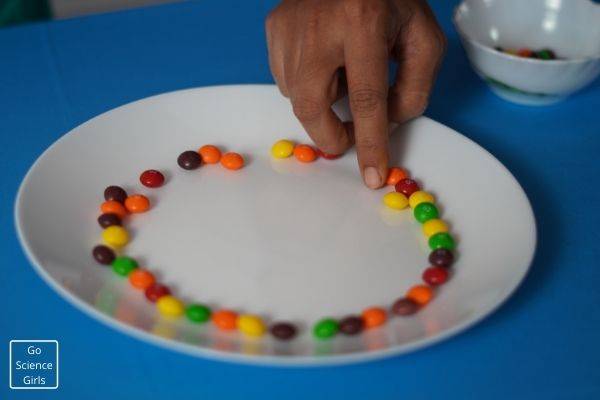
Pick your work plate and sort out all the collected skittles in a single row around the plate towards outside.
You can see the pictures attached to get an idea on how to arrange the skittles on the plate.
My kids arranged color by color closely in a row. Such that we can see a beautiful and colorful rainbow at the end.
Step-3: Pour Warm Water
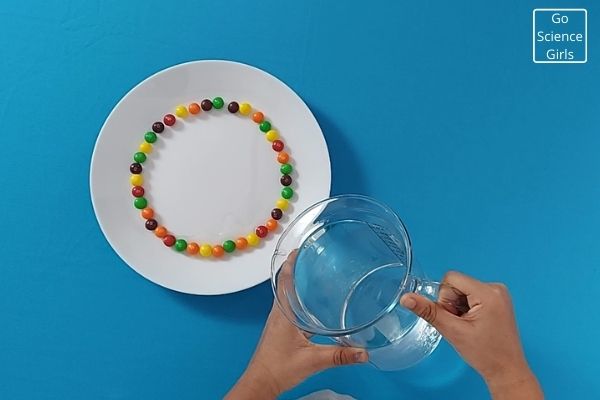
The next step is to pour the warm water carefully and exactly in the middle of the plate.
Warm water works best and fast in absorbing colors. Whatever the water you use, make sure it is clean, fresh and in enough quantity.
Step-4: Wait for Results
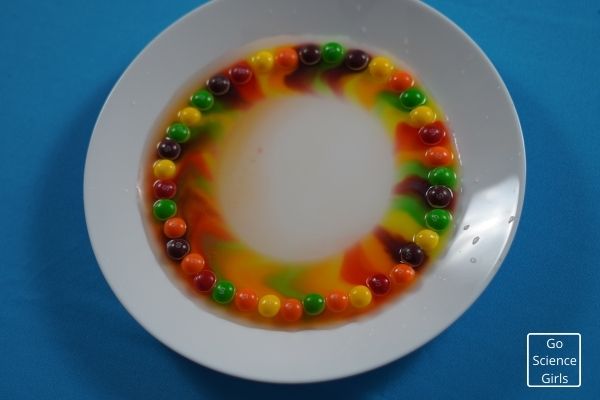
Finally, all you need to do is just wait and observe to see the beautiful outcome i.e. a colourful rainbow.
Yes, when the skittles get wet with the water, they release their respective colors slowly and start travelling towards center of the plate.
All this process happens slowly so give it sometime and observe how colors get mixed up and reveals an attractive rainbow at the end.
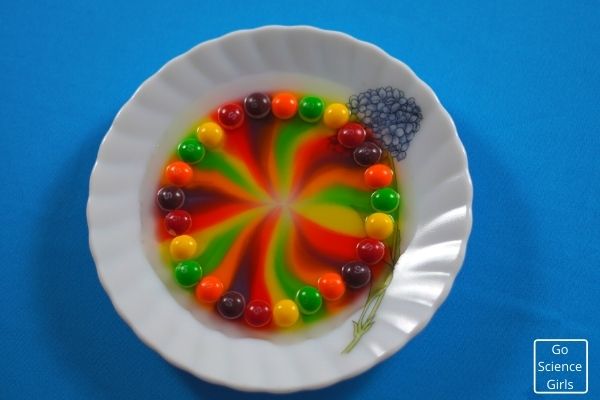
You can see from the residue of the skittle left out in the plate that the colors have dissolved in the warm water.
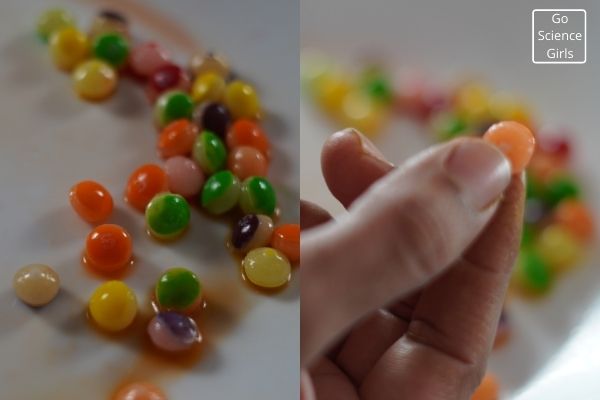
Since we used fresh and safe drinking warm water.. it is absolutely safe for the kids to taste the color mixed water. My younger one liked the mixed juice very much 🙂
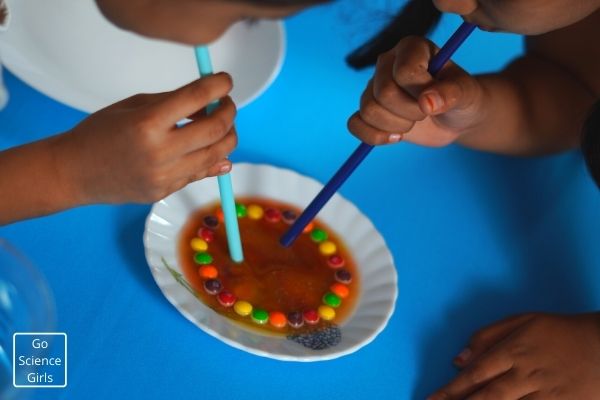
Extension of the Experiment
Using the same skittles, you can do skittles rainbow experiment in different ways like shapes, patterns, etc. Let us see what those patterns are:
Skittles in Alphabet Pattern
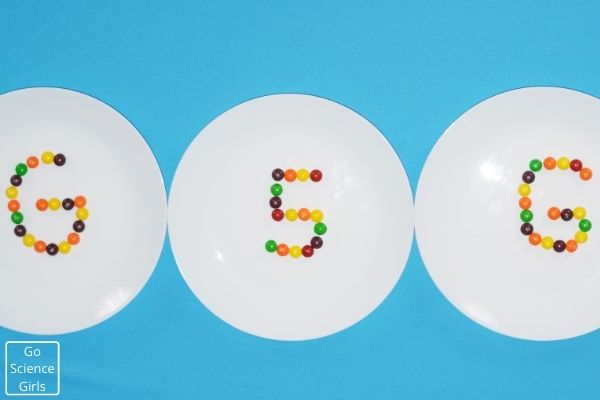
Tear a packet of skittles and pour all of them in to a bowl. Arrange the three ceramic plate’s one after the other adjacently on the experimental table. Now arrange skittles in the shapes of alphabets of your choice.
We chose G, S, and G shapes (to denote Go Science Girls) to create beautiful and colorful patterns using skittles. You can choose to create first letter of your kid’s name.
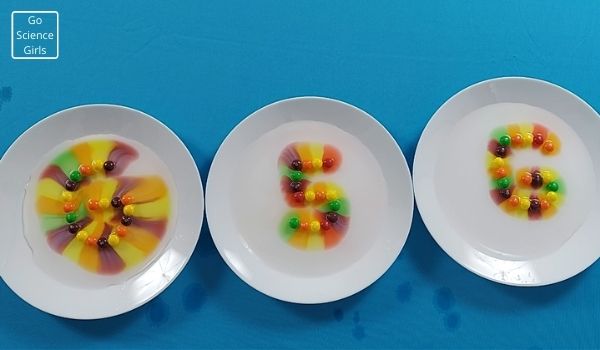
After arranging skittles of your choice, pour warm water on the plate. Let the water reach skittles and wait for some time until the skittles absorb water.
Once the skittles absorb water, they tend to release their respective colors slowly. Do not disturb the plate until the skittles completely release color and dissolve.
Here also, the colors of skittles do not mix up because of water stratification.
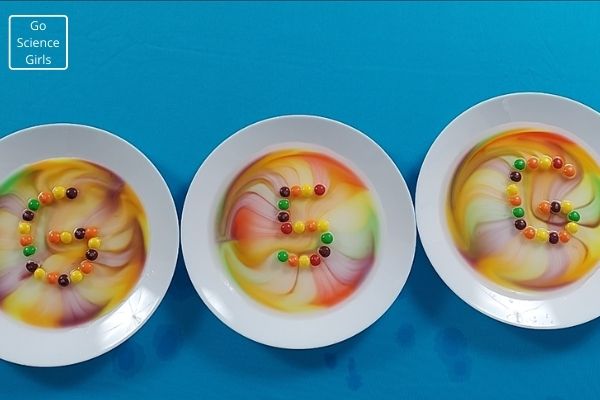
Skittles in Color Patterns
This is another interesting version of observing color patterns using skittles.
The spread of dissolving colors changes with the shape and size of the plate and based on the way you arrange the skittles.
So we tried to make another format. Pick skittles of same colors in three number. As you see in the pictures attached, we took two sets of brown colored skittles in three number and two sets of yellow colored skittles, also in three number.
Arrange the same color sets of skittles in opposite directions on the plate. That means you are placing the two brown colored set of skittles face each other on the plate.
Follow the same with the yellow colored set of skittles. Then pour warm water in to the plate until the skittles completely get wet. Wait for some time!
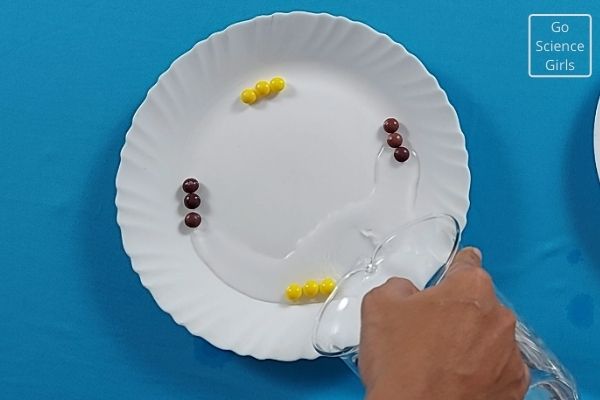
You can see the skittles releasing colors but here the colors of same color skittles get mixed up while dissolving.
If you observe it happens in both the sets. This is because the set of skittles sharing same color show same chemical properties and equations. And hence, the skittles of same color release colors but not in streaks.
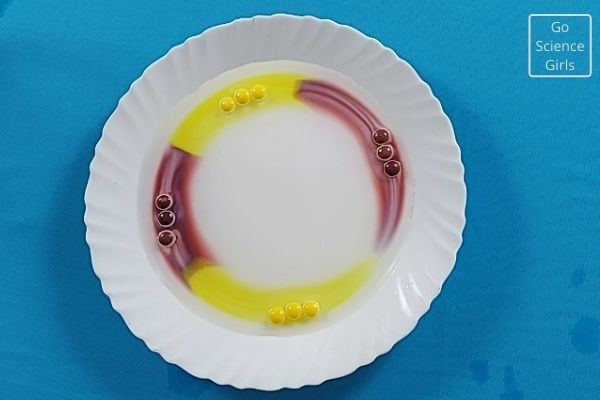
But if you keenly observe, the brown color solution from brown skittles flows towards yellow color solution from yellow skittles. Here the brown and yellow color skittles do not mix up because the chemical properties of both the colors varies and hence forms streaks.
However, brown colored solution is much heavier than yellow colored solution. That is the reason, you can see the movement of color solutions from brown to yellow color skittles.
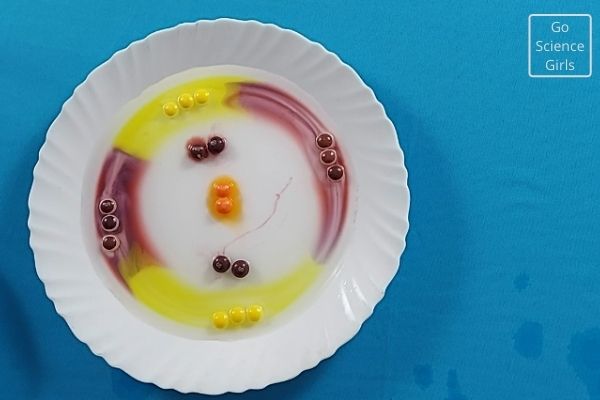
As a next step, place two more orange colored skittles in the middle. And then add two sets of brown colored skittles two number in each set to the plate on either sides of the orange ones.
You can observe skittles slowly absorbing water and start dissolving by releasing its coatings.
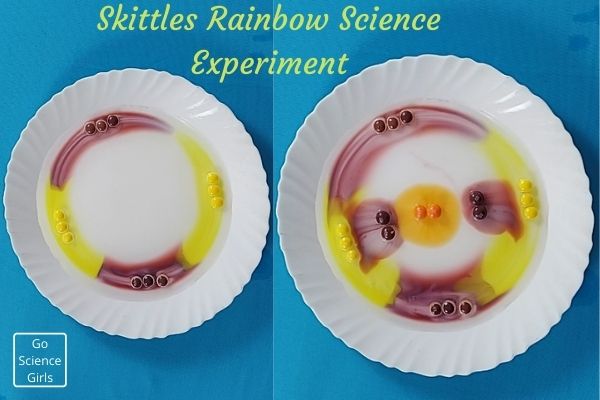
That’s it! You are done with the simple science activity: Skittles Rainbow Experiment.
Children can try it in different color patterns to see the end results differently.
I am very much happy to introduce this simple science activity to the readers because it is the best way to keep your children engaged for hours.
As I already told you, this is a sensory play act for toddlers and kindergarten apart from science activity.
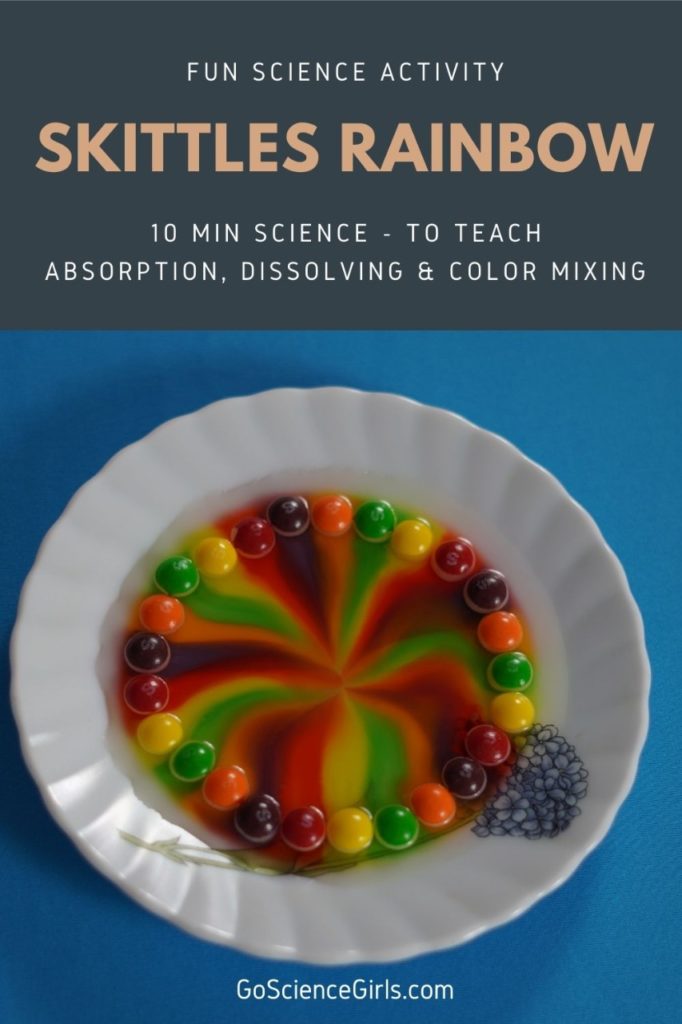
Questions to ask during and after Experiment
Asking questions make your child’s brain thinking much smarter and supports to develop thinking and critical skills.
Here is the list of questions you can ask and discuss with your child while performing skittles rainbow experiment.
1) Why do skittles release colors?
2) Is water the only liquid to dissolve skittles?
3) How long a skittle takes to dissolve completely?
4) Which colored skittle releases its coatings faster?
5) What are the dissolving rates of different colored skittles?
6) If there is any difference in dissolving rates, what could be the reason behind it?
7) Why warm water is perfect for dissolving skittles?
8) How cold and hot water makes difference in dissolving skittles?
9) Are there any other candies that replace skittles in this experiment?
10) At what speed the skittles are absorbing water and dissolving their respective colors?
What is the science involved in this simple Activity?
The experiment with skittles looks simple but it hides a lot of simple science concepts such as absorption, dissolving properties, and color mixing properties. Let us see about these concepts in detail through our skittles experiment:
Skittles are nothing but the sweet candies highlighted with food coloring and sugar sheet.
Basically, this coating represents a dye, which dissolves in water immediately after coming in contact.
Hence, skittles make a perfect choice for this experiment to learn various science concepts.
When skittles get in touch with water, it starts releasing its respective color slowly.
And once the skittles are completely submerged in water, you can see the colors dissolving completely and do not mix up with other colors.
The dissolving nature of skittles and its colors makes a wonderful and fascinating rainbow.
Why the released colors do not mix up? Because of water stratification! Of course, the colors get dissolved so easily when mixed with water but still each color shows different chemical properties.
That is why the colors dissolved do not mix and do follow travelling towards inside of the plate in a streak.
The streaks of dissolving skittles colors maintain to flow in a line towards the centre of the plate because the amounts of food coloring and sugar are same.
As the skittles have same quantities of sugar and color dye coatings, they maintain to flow in a line or streak.
Here we need to talk about concentration levels as well! We know that particles of any solution travel from higher concentration to lower concentration.
As the water when mixed with skittles becomes highly concentrated than the water in the middle of the plate.
So, the color water moves from skittles side to the center of the plate.
Apart from science, I would like to add a few more science definitions in detail to make the concepts clearly understand to your child. Here we go!
Absorption
Absorption is nothing but a simple process in which the molecules of one substance enters into the molecules of another substance.
To put it simple, the matter of one substance completely transfer its energy and components to other substance.
Absorption is different from adsorption and has different meanings in different fields. Below are a few definitions of absorption:
In biology, absorption of various components in to the body through skin is known as skin absorption.
Drugs entering in to the body is also a kind of absorption in pharmacology terms. Absorption of nutrients, electrolytes, minerals, energy, and water from food in to the blood and cells of human body is known as absorption in digestive system.
And if it is a chemical reaction, based on the solute and solvent reactions, there are two types of absorptions: Chemical and Physical Absorption
Dissolving
Dissolving is nothing but making a clear solution using different matters of substances like liquids and solids.
When you dissolve a solid substance in liquid i.e. water, the components of solid completely dissolves in water and finally makes a clear solution.
It doesn’t mean the solid components completely vanished in water because they are just mixed up with water molecules.
Substances that dissolve in water are known as soluble substances while those do not dissolve are known as insoluble substances.
Color Theory
If you are introducing your kid to colors, then you should follow the color theory to make it easy for them to understand.
Color theory is nothing but mixing of primary colors to discover new and secondary color combinations.
Kids can explore new colors by combining pigmented colorants around them, which also helps as science exploration.
Color theory helps children in following ways:
- Makes coloring projects more enjoyable
- Helps in creating a variety of fine art canvas
- Helps to easily understand the basic color combinations
- Improves color mixing skills when limited with a few color options
- Helps in improving skills in water painting, acrylic painting, oil painting, pastel painting, etc.
FAQ’S
Absorption, Dissolving, Concentration, Water stratification, and color mixing are the key science concepts that plays major role in rainbow skittles science activity.
When you pour the water in the middle of the plate, water makes the skittles wet.
As soon as the skittles dissolved in water, they start releasing their own colors in a streak because of water stratification.
Water stratification is nothing but non-mixing up of colors as the colors show different chemical properties.
Water stratification is the only reason for why the colors of skittles do not mix when they release their respective colors.
Skittles are available in different colors and each and every color show different chemical properties, which keeps the colors from mixing up.
When you pour hot water on the plate arranged with different colored skittles in a single row, skittles absorbs water.
After absorbing water, skittles dissolve their respective colors in streaks. If you want to see a beautiful rainbow, then arrange skittles in rainbow color order on the plate and then pour warm water.
Now, wait for some time and observe the fascinating formation of rainbow on the plate using skittles.
Skittles easily get dissolves in warm water but there are some other liquids that dissolves skittles quickly. Those liquids include: vinegar, salt water, lemon juice, etc.
Yes, vinegar has the capacity to dissolve skittles but the process happens very slowly.
Because the acidic molecules do not like to react with sweet molecules. If skittles are submerged in vinegar the acidic molecules in vinegar react slowly with the sugar molecules and makes dissolving process slow. Sometimes, vinegar alone cannot dissolve skittles.
Generally, it takes 15-20 minutes to dissolve a skittle completely in normal water. If you want to dissolve skittles even faster, then you need to use warm water.
Yes, a little amount of warm water makes the dissolving process faster and offers amazing results.
Because the water molecules in warm water move faster with more energy. That is the reason, warm water molecules reach the skittles so quickly and dissolve them very fast compared to cold water.
It takes 20 minutes to completely dissolve a skittle in water. When you submerge skittles in water, in the first two minutes, skittles start absorbing water.
In the next ten minutes, skittles start releasing respective colors. After another ten minutes, you can see half dissolved skittles in your plate. And finally wait for some more time to dissolve a skittle completely.
Warm water is the best liquid to dissolve skittle faster. In addition, the other liquids that dissolve skittles include: vinegar, lemon juice, alcohol, coke, milk, etc.
Skittles come in different colors and each color has different chemical properties. So, the dissolving nature of skittles depends on the color it is coated with.
Skittles look attractive because of its colorful coatings i.e. food coloring and sweet coatings.
These two coatings are the favorable ingredients to water because water molecules easily tend to react with.
When you make the skittles to sit in water for a few minutes, the coatings of food coloring and sugar start dissolving as a first reaction.
Printable Resources
https://asi.fullerton.edu/wp-content/uploads/Skittles-Rainbow-Experiment.pdf
